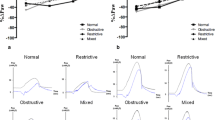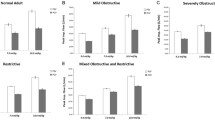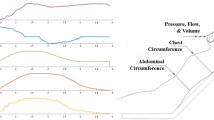Abstract
During proportional assist ventilation, elastic and resistive unloading can be delivered to reduce the work of breathing (WOB). Our aim was to determine the effects of different levels of elastic and resistive unloading on the WOB in lung models designed to mimic certain neonatal respiratory disorders. Two dynamic lung models were used, one with a compliance of 0.4 ml/cm H2O to mimic an infant with respiratory distress syndrome and one with a resistance of 300 cm H2O/l/s to mimic an infant with bronchopulmonary dypslasia. Pressure volume curves were constructed at each unloading level. Elastic unloading in the low compliance model was highly effective in reducing the WOB measured in the lung model; the effective compliance increased from 0.4 ml/cm H2O at baseline to 4.1 ml/cm H2O at maximum possible elastic unloading (2.0 cm H2O/ml). Maximum possible resistive unloading (200 cm H2O/l/s) in the high-resistance model only reduced the effective resistance from 300 to 204 cm H2O/l/s. At maximum resistive unloading, oscillations appeared in the airway pressure waveform.
Conclusion: Our results suggest that elastic unloading will be helpful in respiratory conditions characterised by a low compliance, but resistive unloading as currently delivered is unlikely to be of major clinical benefit.
What is Known: • During PAV, the ventilator can provide elastic and resistive unloading. |
What is New: • Elastic unloading was highly effective in reducing the work of breathing. • Maximum resistive unloading only partially reduced the effective resistance. |




Similar content being viewed by others
Abbreviations
- ACV:
-
Assist control ventilation
- BPD:
-
Bronchopulmonary dysplasia
- ETT:
-
Endotracheal tube
- IMV:
-
Intermittent mandatory ventilation
- PAV:
-
Proportional assist ventilation
- PEEP:
-
Positive end expiratory pressure
- PTV:
-
Patient triggered ventilation
- RDS:
-
Respiratory distress syndrome
- WOB:
-
Work of breathing
References
Bhat P, Patel DS, Hannam S, Rafferty GF, Peacock JL, Milner AD, Greenough A (2015) Crossover study of proportional assist versus assist control ventilation. Arch Dis Child Fetal Neonatal Ed 100:F35–F38
Leipala JA, Iwasaki S, Lee S, Milner AD, Greenough A (2005) Compliance and resistance levels and unloading in proportional assist ventilation. Physiol Meas 26:281–292
Otis AB (1964) The work of breathing. In: Fenn WO, Rahn H (eds) Handbook of physiology, sect 3, vol I. American Physiological Society, Washington DC, pp 463–476
Patel DS, Rafferty GF, Hannam S, Lee S, Milner AD, Greenough A (2010) In vitro assessment of proportional assist ventilation. Arch Dis Child Fetal Neonatal Ed 95:F331–F337
Schulze A, Rich W, Schellenberg L, Schaller P, Heldt GP (1998) Effects of different gain settings during assisted mechanical ventilation using respiratory unloading in rabbits. Pediatr Res 44:132–138
Schulze A, Gerhardt T, Musante G, Schaller P, Claure N, Everett R, Gomez-Marin O, Bancalari E (1999) Proportional assist ventilation in low birth weight infants with acute respiratory disease: a comparison to assist/control and conventional mechanical ventilation. J Pediatr 135:339–344
Schulze A, Jonzon A, Sindelar R, Schaller P, Dammann V, Sedin G (1999) Assisted mechanical ventilation using combined elastic and resistive unloading in cats with severe respiratory failure: effects on gas exchange and phrenic nerve activity. Acta Paediatr 88:636–641
Schulze A, Rieger-Fackeldey E, Gerhardt T, Claure N, Everett R, Bancalari E (2007) Randomized crossover comparison of proportional assist ventilation and patient-triggered ventilation in extremely low birth weight infants with evolving chronic lung disease. Neonatology 92:1–7
Shetty S, Bhat P, Hickey A, Peacock JL, Milner AD, Greenough A (2015) Proportional assist versus assist control ventilation in premature infants. Eur J Pediatr [in press]
Stokes GM, Milner AD, Johnson F, Hodges IG, Groggins RC (1981) Measurement of work of breathing in infancy. Pediatr Res 15:22–27
Younes M (1995) Proportional assist ventilation, a new approach to ventilatory support theory. Am Rev Respir Dis 145:114–120
Author’s contribution
AG and ADM designed the study; OC and PB collected the data; all authors were responsible for the production of the manuscript.
Author information
Authors and Affiliations
Corresponding author
Ethics declarations
This article does not contain any studies with human participants or animals performed by any of the authors.
Funding
Drs. Olie Chowdhury and Prashanth Bhat were supported by the Charles Wolfson Charitable Trust. The research was supported by the National Institute for Health Research (NIHR) Biomedical Research Centre based at Guy’s and St. Thomas’ NHS Foundation Trust and King’s College London. The views expressed are those of the author(s) and not necessarily those of the NHS, the NIHR, or the Department of Health.
Conflict of interest
AG has held grants from various ventilator manufacturers; AG and ADM have received honoraria for giving lectures and advising various ventilator manufacturers. OC declares that she has no conflict of interest; PB declares he has no conflict of interest; GFR declares that he has no conflict of interest; SH declares he has no conflict of interest.
Additional information
Communicated by Patrick Van Reempts
Rights and permissions
About this article
Cite this article
Chowdhury, O., Bhat, P., Rafferty, G.F. et al. In vitro assessment of the effect of proportional assist ventilation on the work of breathing. Eur J Pediatr 175, 639–643 (2016). https://doi.org/10.1007/s00431-015-2673-7
Received:
Revised:
Accepted:
Published:
Issue Date:
DOI: https://doi.org/10.1007/s00431-015-2673-7




